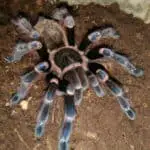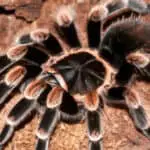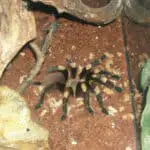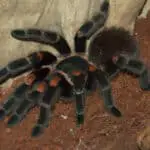While living with pets, you may encounter many unexpected traits. Tarantulas, for instance, do a little dance, especially after eating. While it is adorable for old keepers, it may astonish first-timers. Therefore, why do tarantulas dance?
Tarantulas dance as they weave to keep them safe from predators or watch out for more prey. They also create a surface where they can place their food while eating or need a place to store leftovers. Males also tend to dance when courting females before mating.
We took account of various reports from tarantula owners to determine what it means when their pets dance and why they do it. As you are yet to discover, it is an occurrence that happens often. Read on as we give you the fascinating facts on why tarantulas dance.

What Is the Tarantula Dance?
If you are coming across this for the first time, you must be shocked to find out that these shy creatures can bust some moves. It is unheard of for a spider to have a “happy” dance like humans do. Therefore, we intend to explain these phenomena.
Also known as the “happy dance”, the spider spins in small circles with their joints stretched high while raising their bodies. While at it, they seem to be tiptoeing in a circling manner, and, in many cases, you will notice that they carry around their meals.
Similarly, the spider may be securing its food in place by webbing it as the dance continues. Remember that the dance does not have to be in a circle. Sometimes, these arachnids dance in a back and forth motion combined with a few rotational movements.
This kind of dance may be surprising and unheard of, especially to a new keeper. If you witness it for the first time, a lot of thoughts may cross your mind. Concerned keepers worry that their little buddy is unwell, while some brush it off, thinking that their spiders are just happy about their meals. Researchers believe that tarantulas dance for any reason. Primarily, it could be due to satisfaction from a meal, as they find dancing the best way to celebrate a hunt.
The unique habit may not be common to all Tarantula species. You can give your tarantula food countless times but never witness the dancing. Most tarantulas are motivated by food, while some don’t see the need to dance or spin webs. However, some keepers are lucky enough to witness it every time they feed their pets; meaning that the more feeding sessions they have, the more the spiders dance.
If your cute little pet used to dance but has suddenly stopped, then something must be amiss. When the environment is calm, and there are no lurking predators, your spider will easily carry out its normal activities, including the occasional dancing. You can also make the tank homey, such that it resembles its natural setup. Only then will your tarantula live a happy life and feel free to go about its routine.
The tarantula dance is quite epic, and every keeper would wish to witness it. Since the arachnid is a nocturnal animal, they mostly operate at night, making it difficult to see them in the act, especially when you don’t spend quality time together during the day. However, it is advisable to provide a treat, and you might get lucky to see them do a little dance for you. Note that some tarantulas would only do a happy dance during the mating seasons, which may not happen if you keep a single male.
Why Do Tarantulas Dance?
One of the most highly debated spider characteristics are their circling and dancing. Several owners and experts have come up with theories to help explain the occurrence, and their findings will form the bulk of our discussions today. In our research, we will only considered the speculations that have scientific backings to gain more conclusive findings.
Here are some of the reasons why tarantulas dance.
Alert
Many observers state that the dance aids the spiders in webbing, which is critical to detect when predators are approaching. They can easily sense it when something rattles the webs by listening to the vibrations that pass through the tiny threads. Most owners report that they web while dancing, especially before, during, or after eating. The logical reason is that their fangs are busy when they are eating, and they cannot use them for defense.
It could also be a way to keep other creatures at bay and to eat peacefully, probably because they would rather not share their hard-earned meal. They may also be keen on the vibrations from prey.
Also, small insects tend to get entangled in the webbing, which gives the tarantulas an advantage of an extra meal. Immediately they hear any vibrations; it will indicate that something is approaching, and, from there, they stay alert, knowing that a predator is lurking, or it is their lucky day since there’s more to eat.
Hygiene
Tarantulas are known to be tidy and meticulous in everything they do. They prefer a clean home and would do anything to keep it spotless. Some owners speculate that the dancing creates webs, which they use as a cover to prevent tiny food particles from dropping on the ground. With these mat-like weaving, any food they drop will collect, and they will not have to deal with irritating tiny food bits.
The result is a clean tank since their tank will be bacteria-free in the absence of spoilt food. The same way you would place a napkin before you eat is the same way the spider will weave its web while feeding. Similarly, it helps them clean up after themselves to eliminate food remains when they do it after eating. It is fascinating that some tarantulas go as far as balling up their spun webs and take them to the secluded excretion areas.
Convenience
It may also be a matter of convenience. These creatures are clever enough to know that they need a faster and convenient way to eat. Again, it is the same way that humans place their food on a table before eating. Through dancing, they can spin webs to help them hold their food and make it easy to eat. It may be quite tasking to keep holding their meals as they eat; hence, the raised web functions as a mat. It also comes in handy to help them eat faster.
Secondly, it is easier to leave the food on the spun web for them to eat later. When in the wild, they struggle to find food; thus, they may store some to eat later on if they don’t find more. Therefore, it helps them survive when food is scarce. They can conveniently go about other tasks as their food stays in place. It is quite interesting how these spiders have devised alternative ways to use webs to their advantage.
Some owners also believe that it is necessary to help them hunt conveniently, even while eating. When they catch an insect in a particular area, they believe that the region is a great hunting zone. Hence they lay their webs hoping to catch more. If successful, they would have saved time they would have otherwise used to hunt and get their sumptuous meal faster.
Mating Rituals
Although it mostly occurs in the wild, tarantulas have a mating dance. These spiders also have the breeding season like most creatures, where they feel the need to mate. It is usually in the fall, around September, or at any other time of the year, depending on several factors.
During the breeding season, only the males go searching for females as the latter stays put in her burrows. As soon as he finds a mate, the males tend to display a spirited dance to sweep her off her feet, and, if it works, he has to flee to avoid cannibalization. Even when they escape the female’s jaws, male spiders die soon after reproduction.
Finally
The spider dance is a sight to behold. It is entertaining, and most owners love watching their furry buddies circle around or move back and forth. Based on various owner experiences, they do it before, during, or after eating. The most common reason is to create webs, which they use as tables to hold their food or mats to prevent particles from falling in the tank.
It also helps them detect when predators are lurking or when prey is entangled in the threads. Lastly, males also do a little dance when enticing females during mating. Whether it is their happy dance or a way to entice you to add the portions, we would never know. We are only certain that it is a typical occurrence that happens a lot, and you should not worry about it.








